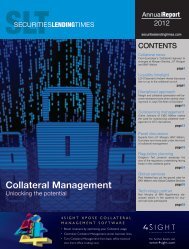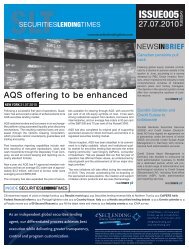read - Securities Lending Times
read - Securities Lending Times
read - Securities Lending Times
Create successful ePaper yourself
Turn your PDF publications into a flip-book with our unique Google optimized e-Paper software.
ForumRound-up<br />
Healthy tension between buy and sell sides<br />
Markit <strong>Securities</strong> Finance hosted more than 150 people representing the great and<br />
the good of the European securities financing market in London for its 16th forum<br />
GEORGINA LAVERS REPORTS<br />
The Markit <strong>Securities</strong> Finance Forum kicked<br />
off a debate on the state of the lender and<br />
borrower relationship.<br />
Last year, it was agreed that it was the regulators<br />
that were really driving the agenda, with<br />
one head of repo noting that the industry is at a<br />
massive inflection point. From a structural perspective,<br />
each person along the securities lending<br />
chain needs to be able to make money if the<br />
industry is to prosper.<br />
This year, a panellist stated that a healthy tension<br />
remains between borrowers and lenders as<br />
they to try seek value for clients.<br />
Despite the major prime brokers having diversified<br />
their businesses with functions such as synthetics,<br />
delta one and swaps driving alternative<br />
routes to market, the overall relationship with<br />
lenders had not been adversely affected, according<br />
to a head of prime finance and delta one.<br />
However, the securities lending value chain<br />
came in for some criticism from a different delta<br />
one head for being rigid, not allowing niche players<br />
and failing to adapt to changes in regulation.<br />
On the question of a trade repository for the<br />
industry, a panel agreed that it was inevitable<br />
and that it will probably take about five years.<br />
On that basis, there is a great opportunity for the<br />
industry to come together voluntarily, or regulators<br />
will impose their version. However, one<br />
panellist warned that a trade repository needs to<br />
focus on positions and exposure rather than be<br />
distracted by individual transactions.<br />
The old adage ‘collateral is king’ needs updating,<br />
with cash now usurped by collateral. A Markit survey<br />
of its consulting clients revealed a split with<br />
40 percent of beneficial owners questioned being<br />
less flexible towards collateral upgrade trading<br />
whereas 40 percent are now more flexible.<br />
One panellist that explained the decision to lend<br />
is not necessarily within the lender’s control as<br />
it depends on where the beneficial owner is<br />
based as well as the appropriate regulatory regime,<br />
which creates challenges for borrowers.<br />
Furthermore, some large lenders are more concerned<br />
with overall risk-adjusted returns from<br />
lending and are less interested in new structures<br />
such as collateral transformation.<br />
Despite the widening definition of eligible collateral,<br />
no one knows how much will be needed<br />
and the numbers that are mooted are still huge.<br />
Conference attendees could not agree, with 41<br />
percent voting that it could amount to less than<br />
$1 trillion while the same amount thought between<br />
$1 trillion and $4 trillion, and the question<br />
of how many new central counterparties will<br />
crop up to service the industry still remains.<br />
A few panellists thought that securities finance had<br />
been solving the collateral question for decades<br />
and that regulator concerns stem from new players,<br />
such as treasury functions, failing to price collateral<br />
correctly and take appropriate risk decisions.<br />
But another panellist countered that some collateral<br />
transformation involves buy-side institutions<br />
managing their own collateral as European<br />
<strong>Securities</strong> and Markets Authority regulations<br />
require different pools of collateral for each type<br />
of activity with re-use of collateral not permitted.<br />
A different panellist noted that collateral is becoming<br />
its own asset class for the buy side and<br />
that they need help getting their arms around<br />
the operational challenge.<br />
Yet one panellist took a different tone, contending<br />
that the collateral shortfall debate is overhyped<br />
and that one of the unintended consequences<br />
is that buy-side players that find the<br />
whole derivatives market too complex will simply<br />
pull back. SLT<br />
17 www.securitieslendingtimes.com












